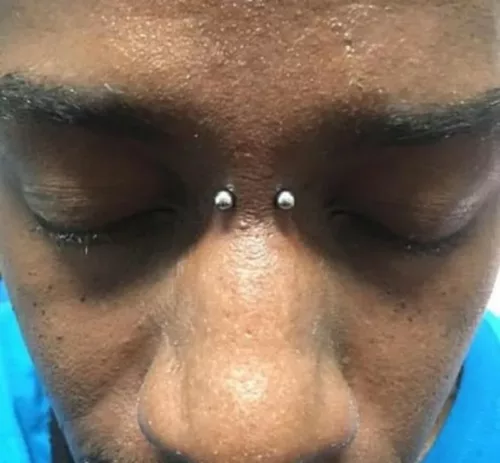Bridge Piercing in Nairobi, Kenya
(Process, Pain Threshold, Healing, Aftercare Rules, and Jewelry)
Bridge piercing is a type of facial piercing that is located on the bridge of the nose, between the eyes. It is done using a needle, which is then replaced with a piece of jewelry of the individual’s choice. Bridge piercings can be prone to infection and other complications if not properly cared for, so it’s important to follow the aftercare instructions provided by a professional piercer.
Bridge Piercing
How Is a Bridge Piercing Done?
A bridge piercing is done with a sterile needle. Your piercer will first examine your skin and nose before discussing the dangers and what to anticipate. To be sure you want to proceed, they will mark the area and then demonstrate what it would look like.
Your piercer will then use an antiseptic cloth or solution to clean the area. A hollow, sterile needle will be inserted into your nasal bridge once the skin has been thoroughly cleaned. Then, a sterile barbell is inserted through your skin and fixed in position.
Your piercing ought to only be carried out with a hollow needle for best results. When you pierce your skin, a layer of skin cells known as epithelial cells help the wound heal over time. These cells form a tube-like structure of skin inside the puncture. You’ll need to leave your barbell in for 8 to 10 weeks to allow the skin to heal.
Body piercings often include the use of a piercing gun, however this is risky. Your skin tissues are crushed by a piercing gun, which can be problematic. There could be considerable scars if the skin doesn’t heal properly. The risk of exposure to bacteria or blood-borne illnesses is also greater with these guns since they are harder to sterilize.
Considerations before getting an Bridge Piercing
Getting a bridge piercing is a significant decision, and there are several important considerations to keep in mind before proceeding. Here are some factors to think about:
- Facial Anatomy and Placement: Consider the placement of the bridge piercing and how it will complement your facial features. Make sure you are comfortable with the position and visibility of the piercing.
- Professional Piercer: Research and choose a professional piercer with a good reputation and experience in performing bridge piercings. Look for reviews and ask for recommendations if possible.
- Health and Medical Conditions: Consult with your piercer and be honest about any medical conditions or allergies you have. Certain medical conditions or medications may affect your ability to get a piercing.
- Pain Tolerance: Be prepared for some discomfort or pain during the piercing process. Everyone’s pain tolerance is different, so it’s essential to mentally prepare yourself.
- Healing Time: Understand that bridge piercings have a healing period that can last several weeks to several months. Consider if you can commit to the necessary aftercare during this time.
- Aftercare Commitment: Be ready to follow the aftercare instructions provided by your piercer diligently. This includes cleaning the piercing regularly with a saline solution and avoiding touching the piercing with dirty hands.
- Risk of Rejection and Migration: Be aware that bridge piercings are prone to rejection or migration, where the body pushes the jewelry out over time. This can lead to the piercing moving or even falling out.
- Jewelry Selection: Discuss jewelry options with your piercer. Choose high-quality jewelry made from materials like surgical steel, titanium, or biocompatible materials to minimize the risk of complications or allergic reactions.
- Facial Expression and Movement: Consider how the piercing might affect your facial expressions, especially if you’re in a profession or situation where maintaining a certain image is important.
- Lifestyle and Activities: Think about how the piercing might impact your daily life, including activities like wearing glasses or participating in sports.
- Visibility and Social Acceptance: Keep in mind that bridge piercings are quite visible and can be a statement piece. Consider whether this level of visibility aligns with your personal style and whether it’s acceptable in your workplace or school.
- Future Plans: Consider any future plans or career goals that may be affected by the piercing. Some professions or workplaces have strict policies regarding facial piercings.
- Consultation: Before getting the piercing, schedule a consultation with your chosen piercer to discuss your expectations, ask any questions, and receive personalized advice.
Remember that bridge piercings, like all body piercings, come with certain risks and require responsible aftercare. It’s essential to be well-informed and make a decision that aligns with your preferences, lifestyle, and comfort level. Consult with a professional piercer who can provide guidance specific to your situation.
How Painful is A Bridge Piercing?
The level of pain experienced during a bridge piercing can vary from person to person. Some people describe it as a sharp, brief pain, while others describe it as more of a discomfort or pressure. Pain tolerance is subjective and can depend on factors such as individual anatomy, anxiety, and adrenaline levels. It’s generally considered to be less painful than other facial piercings, such as a nose or septum piercing, but everyone’s experience is different. Additionally, pain can also vary depending on the skill and technique of the piercer.
Bridge Piercing Healing and Aftercare Tips
The healing process for a Bridge Piercing takes about 4 to 6 months, however internal healing may take longer. Your aftercare routines will have a big impact on how quickly you heal. You should visit your piercer to confirm it’s fully healed before discontinuing aftercare procedures because it will seem healed before it has healed completely.
Bridge Piercing healing process
The healing process for a bridge piercing, like most body piercings, can vary from person to person. It typically takes several weeks to several months for a bridge piercing to fully heal. Proper aftercare is crucial during this time to minimize the risk of complications and promote successful healing. Here is a general overview of the healing process for a bridge piercing:
- Initial Swelling and Redness (Days 1-7): After getting a bridge piercing, you can expect some swelling and redness around the piercing site. This is a normal part of the healing process and typically peaks within the first few days.
- Pain and Discomfort (Days 1-7): You may experience some pain, tenderness, and discomfort during the initial days after the piercing. Over-the-counter pain relievers like ibuprofen can help alleviate this.
- Healing Duration (Weeks to 4-6 Months): Bridge piercings can take anywhere from 6 to 12 weeks or more to fully heal. Healing times vary from person to person, and factors like proper aftercare and your body’s response to the piercing can influence the healing process.
Although the bridge piercing may appear to require a rigorous aftercare regimen, surface piercings heal similarly to other piercings.
Aftercare Tips
Don’t snag the jewelry, please. If you use glasses or sunglasses, this is extremely crucial. Make sure your bridge piercing won’t interfere with the bridge of your spectacles when you have it placed, and take care when removing or putting them on while they’re healing.
Keep cosmetics and skincare away from the jewelry. These have chemicals in them that irritate skin and cause rejection and infection.
Here are the general steps for cleaning a bridge piercing:
- Wash your hands thoroughly before touching your piercing.
- Clean the piercing with saline solution, as directed by your piercer. This can be purchased at a piercing studio or online.
- Apply the saline solution to a cotton ball or Q-tip and gently clean the piercing and surrounding area.
- Rinse the piercing thoroughly with water to remove any residue from the saline solution.
- Repeat this process two to three times a day, or as directed by your piercer.
It’s important to avoid using alcohol, hydrogen peroxide, or any other harsh products on the piercing, as these can irritate the skin and delay the healing process. If you notice any signs of infection, such as redness, swelling, or discharge, contact your piercer or a healthcare professional as soon as possible.
Bridge Piercing Jewelry
The most common type of jewelry used for bridge piercings are straight barbells or curved barbells. These are usually made of implant-grade materials such as titanium, stainless steel, or 14k/18k gold. The choice of jewelry depends on personal preference and the anatomy of the piercing. It’s important to choose jewelry that is the correct size and length to ensure proper healing and to prevent migration or rejection of the piercing. Your piercer will be able to recommend the best type of jewelry for your specific piercing. It’s also important to keep in mind that initial jewelry should not be removed or changed for at least 6 to 8 weeks after the piercing is done to ensure proper healing.
How To Change Your Jewelry
The bridge piercing’s position means that switching out the jewelry may require some practice. Simply take the internally threaded bead end off one side of the straight barbell, insert the bar gently through your piercing, and tighten the bead end into place. To prevent stripping the threading, make sure it’s not too tight.
You could first find it difficult to switch out your jewelry due to the piercing’s location and the length of the piercing tunnel. If you need assistance, go to your piercer so that you don’t interfere with the piercing too much. Additionally, they’ll be able to teach you some methods so that you may make future changes on your own.
Contact Us Today to try the bridge piercing now for a trendy and intriguing look.
OUR LOCATION
Areas We Serve
NAIROBI
KIAMBU
KAJIADO
MACHAKOS


